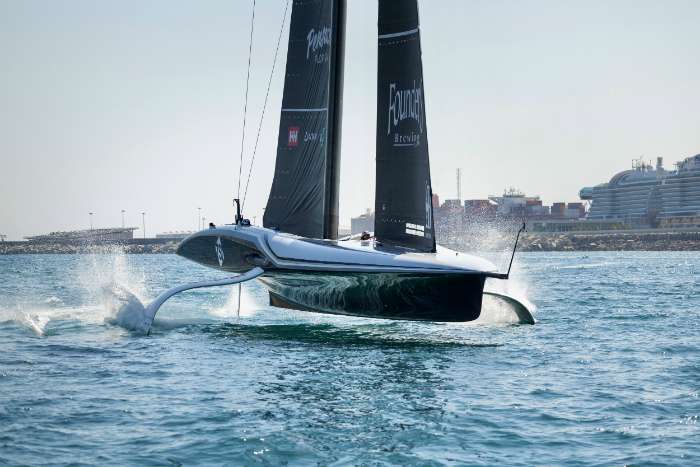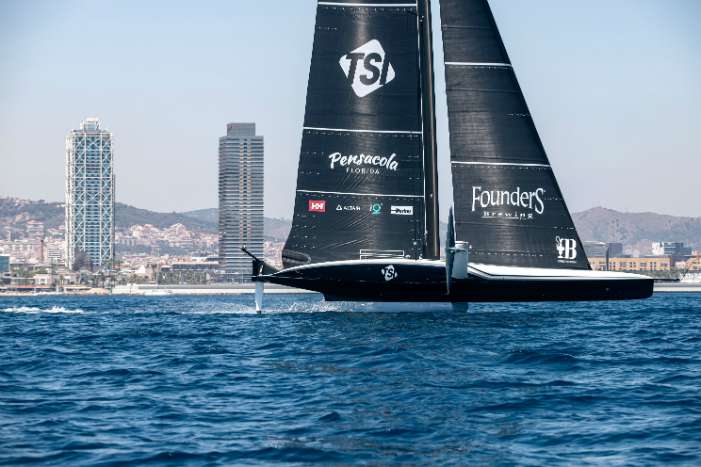Meet Britt Ward, Lead of Hull Design Team for American Magic AC75 Sailing Machine
In SpinSheet’s September issue, we spoke with Annapolis native and head of American Magic sailing operations Terry Hutchinson about the American Magic Challenge that is now racing for the right to challenge Emirates Team New Zealand in the 37th America’s Cup match. The American Magic connections to Annapolis go even deeper. Recently we chatted with Britt Ward, partner at the Annapolis-based Farr Yacht Design and the guy in charge of developing the hull form of Patriot 3, American Magic’s new AC75.

Since March, Ward has been on site with American Magic in Barcelona, Spain. Part of a team of more than 100 people working every day to make Patriot faster.
It might not be the America’s Cup of old where we had races lasting hours and never topped 11 knots of boatspeed, yet watching two state-of-the-art AC75’s match racing in close quarters at 40-plus knots on a really small course is a remarkable sight.
“We’re still trying to harness the forces of the wind as efficiently as possible,” he says. Only now we are flying above the water on hydrofoils and have to keep it flying above the water, too. In the 2007 America’s Cup, our boats were going 10 to 11 knots. Now we’re racing in close quarters at 30 to 50 knots”
For a little perspective he adds, “It wasn’t until 2009 that Macquarie Innovations broke through the 50-knot barrier on a custom-built speed machine that could only sail on one tack.”
Growing up in Fremantle, Western Australia, Ward has been chasing the America’s Cup in one way or another since he was 12 years old. A graduate in naval architecture and marine engineering (BS) from Webb Institute and Ocean Engineering (MS) from MIT, Ward joined Farr and made Annapolis home in 1996. This is his fifth America’s Cup.
“This is the oldest trophy and may be the hardest thing to win in all of sport. A fast boat is a key piece, but to win it you need to get every piece of the campaign to peak at the right time, and you need to pull together the latest technology. A team of over 100 share that same goal. The best sailors, designers, builders, coaches, control and hydraulics engineers, performance analysts, trainers, and logistics personnel… And still hit that start line at speed and pick the right side of the shifts!”
Really, Ward’s been working full speed for two and a half years, but since his arrival in Spain in March, the teams been workings six days a week, or more, getting the boat fitted-out, tuned up, and race ready.
“These are incredible machines,” he says. “There aren’t many design opportunities where you get to apply the latest technologies and work with some of the best and brightest in so many different disciplines. That’s the most exciting part for me—to work with great people and see ideas and concepts develop from a conversation or a simple sketch to this amazing piece of hardware in two and a half years. It’s such an incredible rush.”
Patriot is crewed by eight sailors, two helmsmen, two trimmers/flight controllers, and four cyclors (cyclist + sailor) that provide the hydraulic power to adjust all of the sail controls. The “flight” control actuation of the foil cant, foil flaps, and rudder rake uses battery-powered hydraulics. Unique to the AC75: none of the crew change sides or position during maneuvers, so every maneuver involves a really careful choreography with helming, trimming, and flight control duties being handed off side to side.
When designing a racing machine such as the AC75, the design team has 200-plus pages of rules and technical regulations they must honor—very strict weight and dimensional requirements, for example. Restrictions on the numbers of hulls [one!] and foils [three] we can build. That many regulations can feel a bit stifling, but sometimes having strict constraints can drive you to more creative solutions. Ward and team must ask themselves, “Within that space, where are the areas with the most performance potential, where can we make a leap?”

Given the tight rule space you might think all of the competitors would land in a similar place but the 6 boats competing have all found some pretty different solutions. Of the 6 Patriot may be the most unique. “We’ve opted for a unique cockpit layout with the helmsmen and flight controllers’ side by side and then the four cyclists placed inboard and facing aft in a recumbent position. “
Moving the cockpits inboard allows for a much lower profile deck shape with the deck almost a foot lower than any of the competitors. While the deck layout reflects a big focus on aerodynamic efficiency, the hydrodynamics were also a big consideration.
“Barcelona can have a big sea state that doesn’t necessarily align with the wind, and we are going to race in light air; so being able to take off efficiently, even in waves, was a very big focus… Some of these things are very hard to simulate. You need to really draw on experience to find the best trade-off for all these different aspects.”
Ward adds, “After two and a half years of designing, building, and training, it’s only now that racing has begun that we finally get to see how our solutions stack up against the competition. Early signs are encouraging, but it’s going to be a tough fight all the way to the cup.”
The waters of Barcelona are abuzz with the Louis Vuitton Cup underway. Next up are the semi-finals starting September 14. Ward and his team are ready to watch their magic unfold.
Learn how you can watch at americascup.com. Learn more about American Magic at americanmagic.com and about Farr Yacht Design here.




